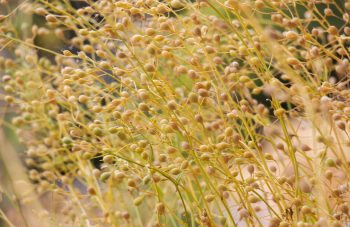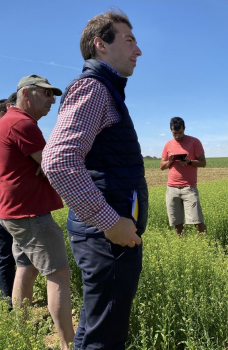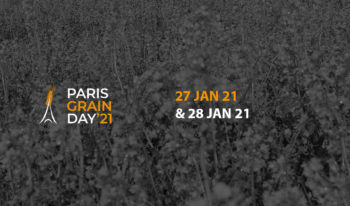With camelina, farmers do not replace a crop, they add one, and market it! Thanks to its very short growth season, this cruciferous plant is suitable for summer intercropping. It stores carbon, restructures the soil, traps nitrates, provides pollen in midsummer for foraging bees, and most importantly, it produces seed for new biofuels.
Camelina, of the flax family, could well be one of the promising avenues for supporting the energy transition in the transport sector. By 2030, the rate of incorporation of renewable energy from all sources should reach 14% in Europe, including a minimum of 3.5% for advanced biofuels, i.e. those using non-food biomass. France has already decided to raise the rate of incorporation of this new energy resource to 2.5% in 2025, compared with 1% in Europe. It should reach 5% by 2030. The challenge is to find the volumes to satisfy the energy sectors. Camelina is among the potentially eligible crops for the production of a biofuel with a very high reduction in greenhouse gases.

Camelina, a candidate for innovative projects
Rich in oil and protein and with a short development cycle of three months, camelina is the ideal candidate for the innovative projects that Saipol has been launching for the past three years to expand its energy offer and, as a complement, it’s animal feed offer. “Our aim is to create a biofuel sector whose raw material comes from the summer intercropping after early harvests of winter crops such as protein pea, canned pea, winter barley and wheat”, explains Guillaume de La Forest, project manager for camelina at Saipol. This cruciferous plant, which is sown from mid-June to mid-July and harvested by mid-October at the latest, fits within this strategy. It will complement Saipol’s energy oil offer, which is mainly based on rapeseed. The challenge is twofold. By mobilising the time between food crops, farmers will be able to earn an income. For the manufacturer, it is an additional local source of supply which can bring new contracts”.
Towards a structured and remunerative Camelina production chain
The possibility of mobilising hectares on French territory must be validated with each operator. Saipol evaluates the quality of the oils obtained in biofuels for the aeronautical industry as well as the quality of the meals obtained from the hulled seeds. Potential buyers in these sectors are following the project with interest. “We are in the process of providing the framework, and the volumes need only enter within this scope” Guillaume de La Forest adds. The project was launched in 2018 to validate the insertion of the crop in the rotation. The next step is the sustainability of the sector. In balance in this “production chain crash test”: the assets and difficulties encountered by farmers and storage organisations. A pilot group was set up in 2020. Camelina has been sown on more than 1,000 ha in partnership with eight storage organisations, the Chambers of Agriculture, the seed company Camelina Company and the technical institute Terres-Inovia. The experiment will increase in importance both in terms of surfaces and yields by the optimisation of technical processes. “We are making step-by-step progress on agronomic knowledge, adds Guillaume de La Forest. In 2022, we will draw up a set of specifications based on these last few years of experiments. We are already committed to buying the lots at a price close to the rapeseed price. ” In order to be ready for launch!
Agro-ecological benefits
The Treatment frequency index for camelina, Camila sativa, is zero:
- Camelina is disease resistant and does not require insecticide treatment.
- Flea beetles like mustard and oilseed rape but flee from camelina
- As it grows quickly, it suffocates weeds.
Yields are around 10 q/ha but input costs are quite low
- 50 euros/ha for sowing
- 40 units of nitrogen/ha to be applied behind a barley for example
- If the previous crop is pea, nitrogen residues avoid fertilisation>
With strong roots, camelina withstands summer heat without being harmed
Rich in nectar and pollen, it provides food for bees at a time when flowers become scarce
Its taproot restructures the soil and traps nitrates.

« The only costs for planting camelina will be the purchase of the seed, fertilisation if necessary and the costs of planting at the time of sowing »
The final adjustments are mainly made at the time of sowing field

What are the most important lessons learned about camelina cultivation? Trials have shown that an average yield of 10 q/ha can be expected, but in good conditions some plots have produced 17 q/ha. These yields may seem low, but they should be seen in the light of very low production costs and similar to a plant cover. The two main expenses are for sowing and fertilisation if the camelina is cultivated after a cereal. The best yields are obtained when camelina is sown in mid-June on no-till soils. The main area for improvement is the sowing technique. “This crop grows very quickly under good water conditions, explains Guillaume de la Forest, head of the camelina project at Saipol. Farmers who are used to sowing plant cover, very quickly after the harvest, without tillage, with localised fertilisation if necessary, have a head start. The challenge is to avoid the risk of summer drought during the emergence period and to reach maturity before sowing the winter crop. ”
In 2021, it’s time for innovation: “We are going to experiment with sowing after an IEC* and also with broadcast sowing in the previous crop, three weeks before its harvest, and with the help of a drone”, Guillaume de la Forest added. A further trial was carried out on sowing in combination with clover, without the use of herbicides, in order to be eligible for the EFA** payment under the CAP. “Our goal is to increase the potential surface to be sown in France”.
*IEC: Intermediate energy crop
**EFA: Ecological focus area (CAP)
Cette nouvelle #interculture est de la #Cameline. Elle est expérimentée par la #SCAEL avec les équipes #Saipol et @CamelinaCompany qui nous ont accompagnés pour un #TourDePlaine. pic.twitter.com/Gn9VCP5iP6
— Groupe SCAEL (@GroupeSCAEL) July 30, 2020
La #cameline : une plante agronomiquement très intéressante dont l'huile a de nombreuses propriétés. La coopérative @valfrancecoop propose à ses sociétaires en Seine-et-Marne de la cultiver https://t.co/4K6GiH77eV pic.twitter.com/vayATQfeCi
— #agridemain (@Agridemain) December 4, 2020


